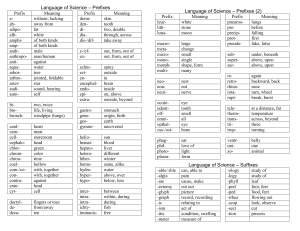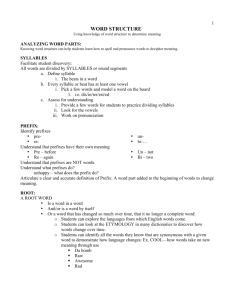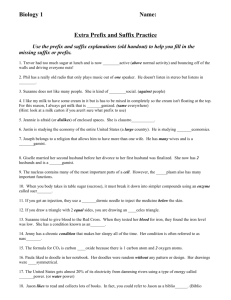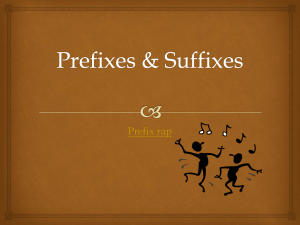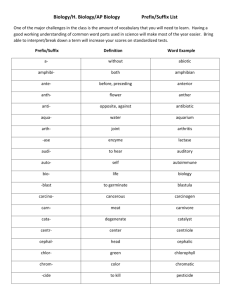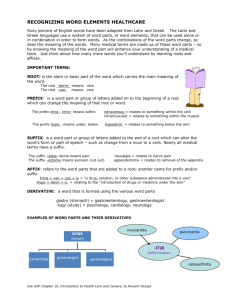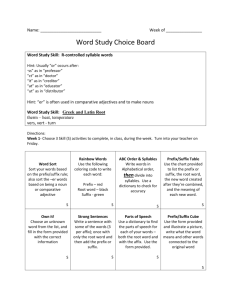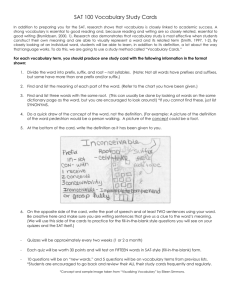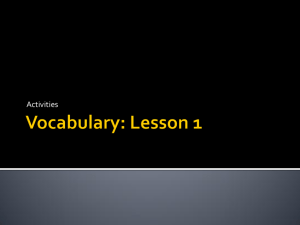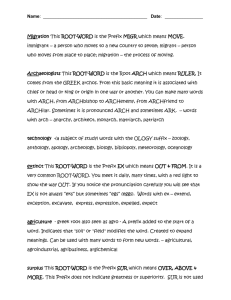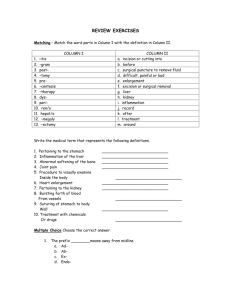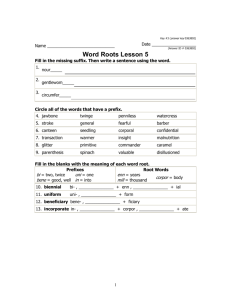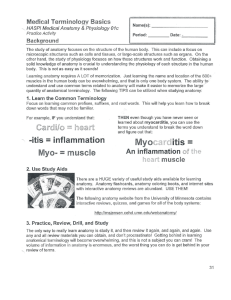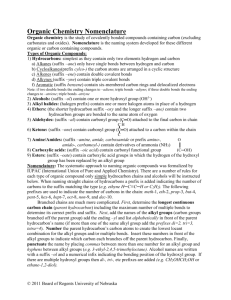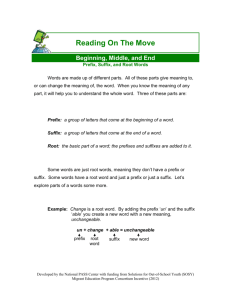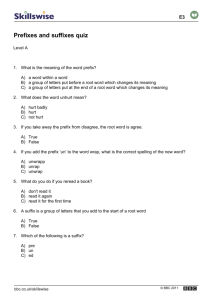Language of Science
advertisement
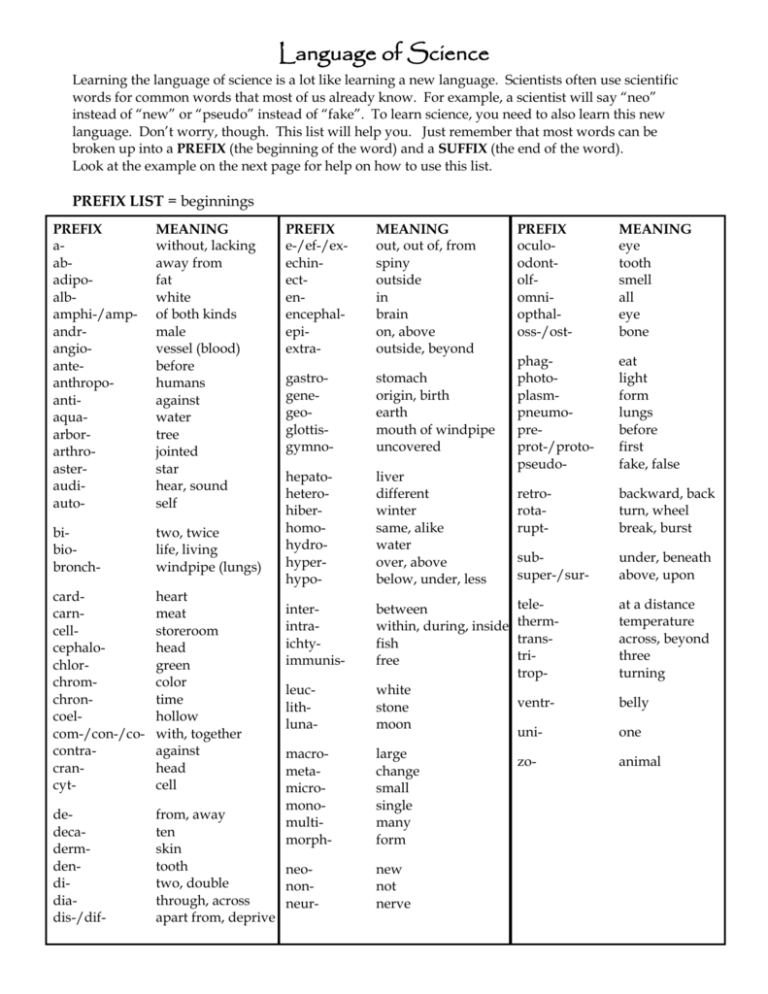
Language of Science Learning the language of science is a lot like learning a new language. Scientists often use scientific words for common words that most of us already know. For example, a scientist will say “neo” instead of “new” or “pseudo” instead of “fake”. To learn science, you need to also learn this new language. Don’t worry, though. This list will help you. Just remember that most words can be broken up into a PREFIX (the beginning of the word) and a SUFFIX (the end of the word). Look at the example on the next page for help on how to use this list. PREFIX LIST = beginnings PREFIX aabadipoalbamphi-/ampandrangioanteanthropoantiaquaarborarthroasteraudiauto- MEANING without, lacking away from fat white of both kinds male vessel (blood) before humans against water tree jointed star hear, sound self PREFIX e-/ef-/exechinectenencephalepiextra- MEANING out, out of, from spiny outside in brain on, above outside, beyond PREFIX oculoodontolfomniopthaloss-/ost- MEANING eye tooth smell all eye bone phagphotoplasmpneumopreprot-/protopseudo- eat light form lungs before first fake, false gastrogenegeoglottisgymno- stomach origin, birth earth mouth of windpipe uncovered hepatoheterohiberhomohydrohyperhypo- liver different winter same, alike water over, above below, under, less retrorotarupt- backward, back turn, wheel break, burst bibiobronch- two, twice life, living windpipe (lungs) subsuper-/sur- under, beneath above, upon cardcarncellcephalochlorchromchroncoelcom-/con-/cocontracrancyt- heart meat storeroom head green color time hollow with, together against head cell interintraichtyimmunis- between within, during, inside fish free telethermtranstritrop- at a distance temperature across, beyond three turning leuclithluna- white stone moon ventr- belly uni- one macrometamicromonomultimorph- large change small single many form zo- animal dedecadermdendidiadis-/dif- from, away ten skin tooth neotwo, double nonthrough, across neurapart from, deprive new not nerve SUFFIX LIST = endings SUFFIX -able/ -ible -algia -ectomy -graph -ism -itis -meter -ology/ -logy -phyll -pod/ -ped -scope -sect -sperm MEANING able to, capable of pain cut out instrument for making records act of, condition inflammation (swelling) or disease measure study of, science of leaf foot, feet look, observe cut seed Example of how to use this list Word: TELESCOPE Step 1. Look up the first part of the word under the PREFIX LIST tele = at a distance Step 2. Look for the rest of the word under the SUFFIX LIST scope = look or observe So, the whole word means “distance-look” or to look at something at a distance. Note The order of the words may not always seem right; don’t worry about that. Sometimes you can only find one part of a word but that can be a good clue about the meaning You may have extra letters like o or a or i between two parts of a word—they don’t mean anything If you don’t see a word in the suffix list, check the prefix list. Sometimes, words can be both a prefix and a suffix. Name __________________________ Per ______ Date _________________ Using the Language of Science prefix and suffix lists, figure out the meanings of the following words: Example: cardiology – heart study or science (study of the heart) 1. phototropism— 2. arthropod— 3. echinoderm— 4. epiglottis— 5. multicellular— 6. hypodermic— 7. anthropology— 8. hypothermic— 9. gymnosperm— 10. pseudopod— 11. photograph— 12. autograph— 13. neuralgia— 14. decapod— 15. hepatitis— 16. cytology— 17. zoology— 18. microbiology— 19. geology— 20. biology— Notice that several prefixes can mean the same thing: 21. What are two prefixes that mean ONE or SINGLE? __________ __________ 22. What are two suffixes that mean CUT or CUT OUT? __________ __________ 23. What are two prefixes that mean ABOVE or ON? __________ __________ 24. What are two prefixes that mean TWO? __________ __________ Just knowing one part of a word gives you a clue to the whole word: 25. Would you want to be careful when touching an animal called an ECHINDNA? Yes No 26. What does a CARNIVORE eat? _______________ 27. Is a NEONATE a tiny baby or an old person? ____________________ 28. Is a CRANIOTOMY a serious surgery? Yes No 29. An ALBINO rabbit is what color? _______________ 30. Does an AMPHIBIAN live on land or water? _______________ 31. If a medicine is CONTRAINDICATED for you, should you take it? Yes No 32. A DERMATOLOGIST works with what part of the body? _______________ 33. How does a tiny animal called a ROTIFER travel through the water? ________________________ (hint: look up rota) 34. If you visited the Elysian Park ARBORETUM, what would you expect to see? _______________ 35. In 1969, where did the LUNAR mission land? _______________ 36. What is another name for a CHRONOMETER? _______________ 37. Why do they call this symbol (*) an ASTERISK? __________________________________

